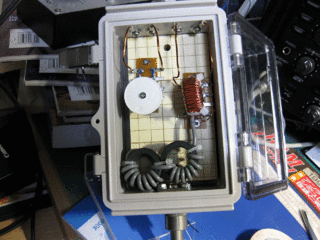![]()
公開日 2008年1月14日 最終更新日 2018年4月21日 by JE2UFF
VP6DXのDXペディションにつきまして、最新のニュースがリリースされました。準備は着々と進んでおり、既に設備関連はZLに到着したようです。
2008 Ducie Island Expedition: VP6DX
(for immediate release ? please feel free to forward this information to
interested parties)
News #6- 2008, January 13th
Highlights:
… Equipment arrives in New Zealand…
… WA6CDR to depart for New Zealand on Thursday…
… On-line QSL request explained…
… Background information: Ducie Island radio site design…
1. Recent events:
All equipment that was shipped from Germany and the USA has now arrived
in New Zealand, and everything except the last air freight shipment
(laptops, microKeyers) has cleared customs in Auckland. This equipment is
now traveling by truck to Tauranga, the home port of the "Braveheart".
On Thursday night this week Robin WA6CDR flies from Los Angeles to
Auckland with the radios and a few other last-minute items. Robin will sail
with the "Braveheart" when it leaves New Zealand January 21st. During the 2
weeks of the voyage from Tauranga to Magareva, Robin will work on
consolidating all the different shipments into the needed order for orderly
transport to shore. Lets hope the sea weather is kind!
The expedition team also wired funds due under its contract with the
"Braveheart" management company for fuel, use of the ship and crew. During
2007 oil prices have increased substantially on world markets, and the US
dollar has declined in strength on world currency markets. These two
changes have increased the cost of the DXpedition, in US dollar terms, by
US$20,000.
2. QSL Information:
On-line QSL information has been added to the website, www.vp6dx.com.
No need to fill out a card or write a letter… and no need for
self-addressed envelopes! Just fill out an on-line form to request QSLs.
Donors will receive accelerated, automated processing of their request.
Verified contacts will be confirmed promptly as soon as printed cards are
available after the expedition. LOTW confirmations will also be
accelerated.
Non-donors will have their requested and verified contacts confirmed with
a printed QSL card, sent via the bureau, and a LOTW entry at a later date.
For people who prefer not to use on-line forms or make on-line donations,
the website explains how to submit a paper request.
Thanks to DL1MGB, DF3CB and OM1AVK for the implementation of on-line QSL
processing.
3. Site Planning:
The "Braveheart" is permitted to carry 13 passengers. With careful
scheduling, 13 operators can staff 7 operating positions 24 hours per day.
Each operator will be on-air 12-13 hours per day, typically in three-hour
shifts with breaks of one hour for meals and other camp jobs. By avoiding
long operating shifts, operators will be more alert and logging accuracy
should improve.
Given likely propagation, how can 7 operating positions be best used?
Late at night 160 through 30, and perhaps 20m, may be the only open bands.
Our solution: two operating locations, separated by about 1.5 km.
The west site will host three operating positions, plus these antennas:
— 75m SSB and 40m: 4-squares.
— 20, 17, 15, 12, and 10m: 2-element vertical dipole arrays.
The east site, near the only safe landing point, will host four operating
positions plus these antennas:
— 160m: one or two element verticals.
— 80m CW, 40m, and 30m: 4-squares.
— 20, 17, 15, 12, and 10m: 2-element vertical dipole arrays.
— 6m: 5-el Yagi (we will try vertical polarization).
The east site also contains our sleeping tents and eating/relaxing area.
With the exception of the narrow 160m and 30m bands, the large separation
between sites should permit us to put two stations on any LF/HF band. The
actual hour-by-hour allocation of stations to
bands/modes depends on:
— propagation: priority given to "edge" bands with the most difficult
propagation.
— geographical balance: priority given parts of the world
under-represented in QSOs made to date on a particular band-mode.
— mode balance: priority given to modes under-represented in QSOs made
to date during band’s opening with a particular region.
Low band receiving antennas will be midway between the east and west
sites. These will be reversible beverage arrays, with each antenna split out
into a separate 160m, 80m CW and 75m output (W3LPL bandpass filters). The
low band operators can choose their listening antenna independently via a
remote controlled switching up. DX Engineering pre-amps boost the signal
from the selected antenna before it travels down the long coax run (750m) to
the operator’s K3 radio. The pre-amps are protected from the low band
transmit signals through a combination of bandpass filters, custom notch
filters (for example, to reject the 80m CW transmitter on the 75m SSB
operator’s antenna), physical separation from the transmit antennas, and
other measures.
A sketch of the site layout will be posted to the website shortly.
73
Carsten, DL6LAU and Eric, K3NA










